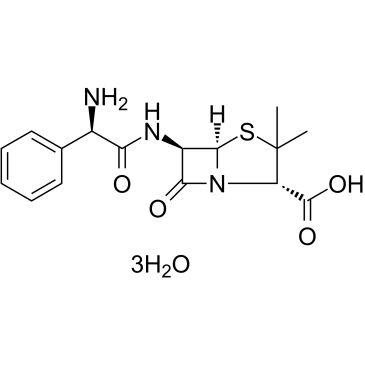Ampicillin Trihydrate

Ampicillin Trihydrate structure
|
Common Name | Ampicillin Trihydrate | ||
|---|---|---|---|---|
| CAS Number | 7177-48-2 | Molecular Weight | 403.451 | |
| Density | N/A | Boiling Point | 683.9ºC at 760 mmHg | |
| Molecular Formula | C16H25N3O7S | Melting Point | 208 °C (dec.)(lit.) | |
| MSDS | Chinese USA | Flash Point | 367.4ºC | |
| Symbol |


GHS07, GHS08 |
Signal Word | Danger | |
Use of Ampicillin TrihydrateAmpicillin trihydrate (D-(-)-α-Aminobenzylpenicillin trihydrate) is a broad-spectrum beta-lactam antibiotic against a variety of gram-positive and gram-negative bacteria. |
| Name | ampicillin trihydrate |
|---|---|
| Synonym | More Synonyms |
| Description | Ampicillin trihydrate (D-(-)-α-Aminobenzylpenicillin trihydrate) is a broad-spectrum beta-lactam antibiotic against a variety of gram-positive and gram-negative bacteria. |
|---|---|
| Related Catalog | |
| In Vitro | Ampicillin trihydrate (D-(-)-α-Aminobenzylpenicillin trihydrate) inhibits the growth of E. coli of swine origin in a dose-dependent manner. The effective inhibitory concentration of Ampicillin trihydrate is 2.5 uG/mL[1]. |
| In Vivo | Ampicillin trihydrate (D-(-)-α-Aminobenzylpenicillin trihydrate) is very effective in alleviating the symptoms of hemorrhagic enteritis in a 11-week old pig[1]. Ampicillin trihydrate produces maximum concentrations in bile twice as high as in serum. The peak concentration of ampicillin after an oral dose is as twice as high in portal blood as in peripheral blood[2]. Ampicillin trihydrate provides neuroprotection against ischemia-reperfusion brain injury. Ampicillin trihydrate reduces the activities of MMPs and increases the expression level of GLT-1. Pretreatment with Ampicillin trihydrate significantly reduces medial hippocampal cell death following global forebrain ischemia[3]. |
| References |
| Boiling Point | 683.9ºC at 760 mmHg |
|---|---|
| Melting Point | 208 °C (dec.)(lit.) |
| Molecular Formula | C16H25N3O7S |
| Molecular Weight | 403.451 |
| Flash Point | 367.4ºC |
| Exact Mass | 403.141327 |
| PSA | 165.72000 |
| LogP | 1.15430 |
| Index of Refraction | 265 ° (C=0.1, H2O) |
| Water Solubility | 0.1-1 g/100 mL at 21 ºC |
CHEMICAL IDENTIFICATION
HEALTH HAZARD DATAACUTE TOXICITY DATA
|
| Symbol |


GHS07, GHS08 |
|---|---|
| Signal Word | Danger |
| Hazard Statements | H315-H317-H319-H334-H335 |
| Precautionary Statements | P261-P280-P284-P304 + P340-P305 + P351 + P338-P342 + P311 |
| Personal Protective Equipment | dust mask type N95 (US);Eyeshields;Faceshields;Gloves |
| Hazard Codes | Xn: Harmful; |
| Risk Phrases | R36/37/38;R42/43 |
| Safety Phrases | S22-S26-S36/37 |
| RIDADR | NONH for all modes of transport |
| WGK Germany | 2 |
| RTECS | XH8425000 |
| HS Code | 2941101100 |
| HS Code | 2941101100 |
|---|
|
Fine mapping and characterization of the L-polymerase-binding domain of the respiratory syncytial virus phosphoprotein.
J. Virol. 89(8) , 4421-33, (2015) The minimum requirement for an active RNA-dependent RNA polymerase of respiratory syncytial virus (RSV) is a complex made of two viral proteins, the polymerase large protein (L) and the phosphoprotein... |
|
|
BBS4 directly affects proliferation and differentiation of adipocytes.
Cell. Mol. Life Sci. 71(17) , 3381-92, (2014) BBS4 is one of several proteins whose defects cause Bardet-Biedl syndrome (BBS), a multi-systemic disorder, manifesting with marked obesity. BBS4 polymorphisms have been associated with common non-syn... |
|
|
An HD-domain phosphodiesterase mediates cooperative hydrolysis of c-di-AMP to affect bacterial growth and virulence.
Proc. Natl. Acad. Sci. U. S. A. 112(7) , E747-56, (2015) The nucleotide cyclic di-3',5'- adenosine monophosphate (c-di-AMP) was recently identified as an essential and widespread second messenger in bacterial signaling. Among c-di-AMP-producing bacteria, al... |
| Ampicillin |
| MFCD00072036 |
| EINECS 200-709-7 |
| Ampicillin Trihydrate |

